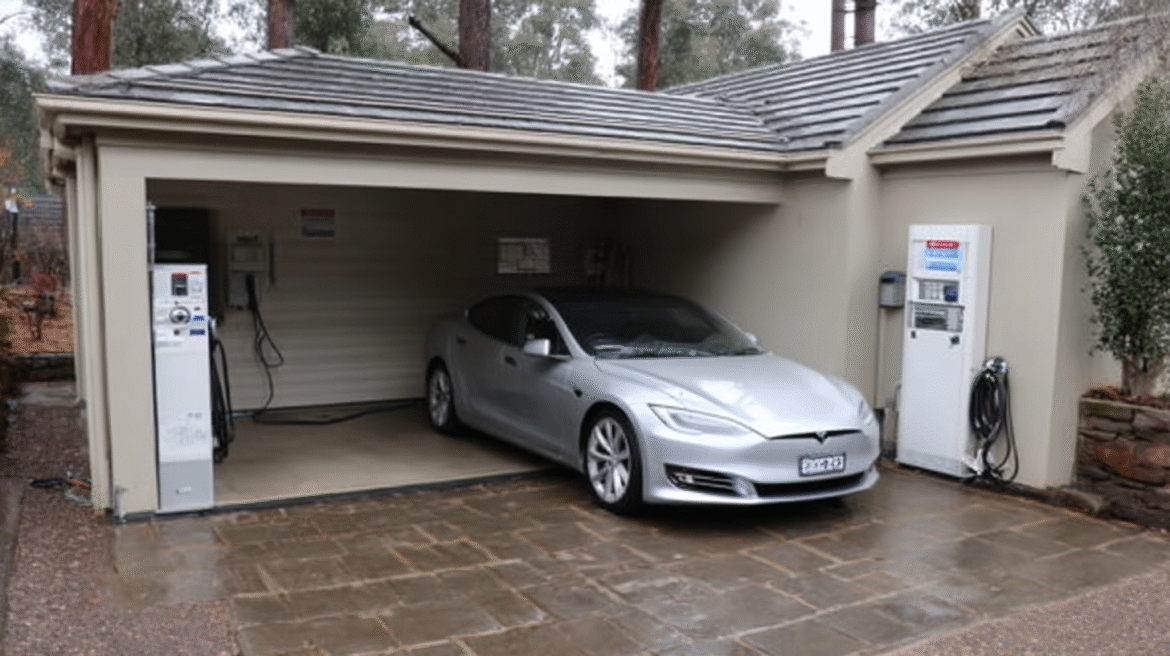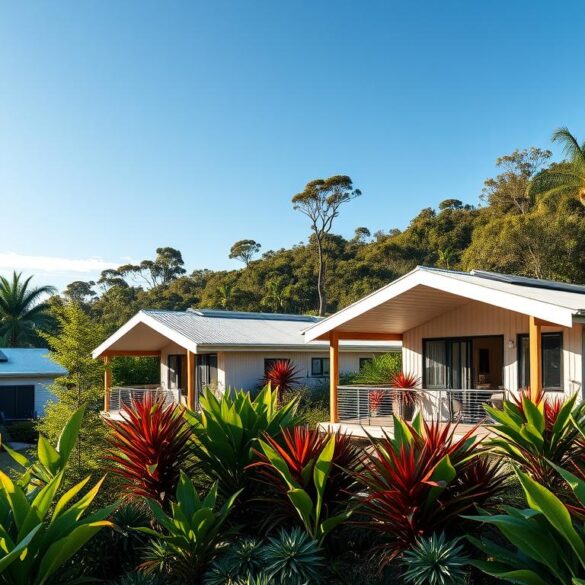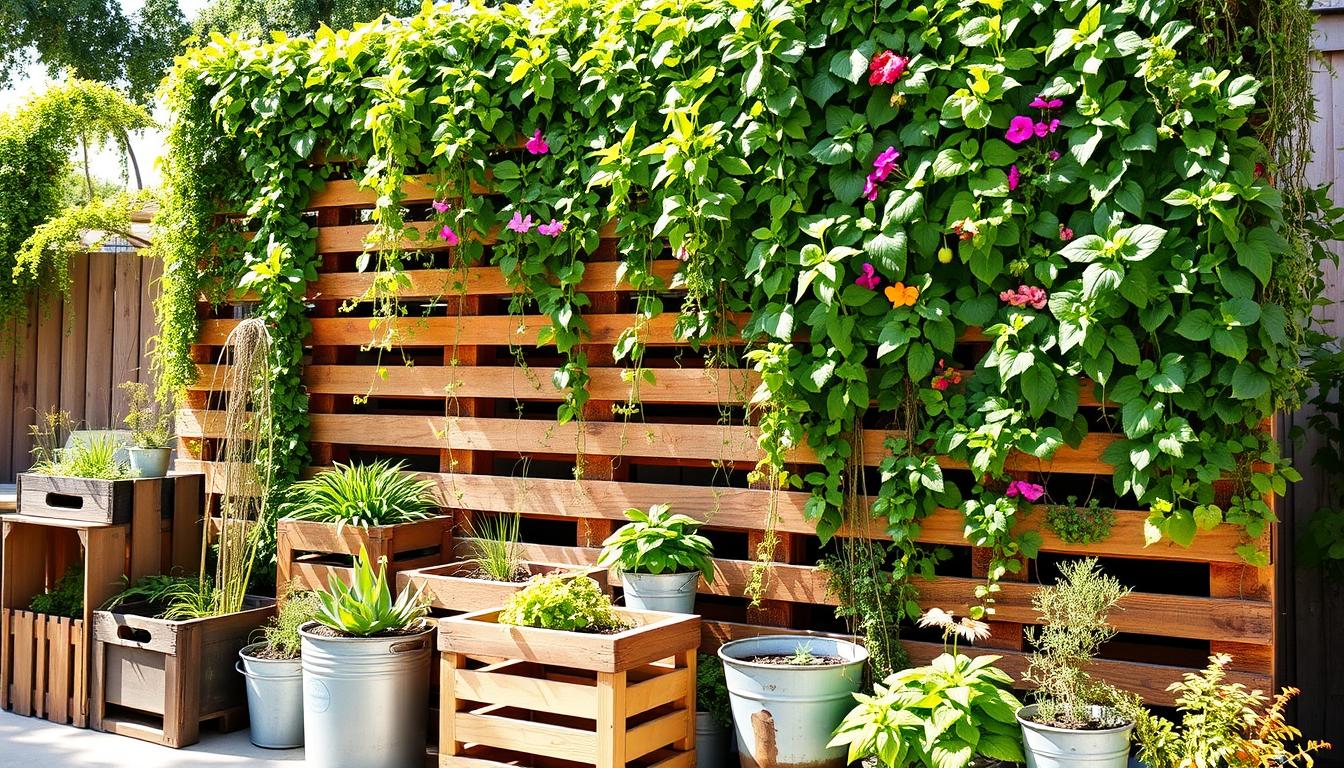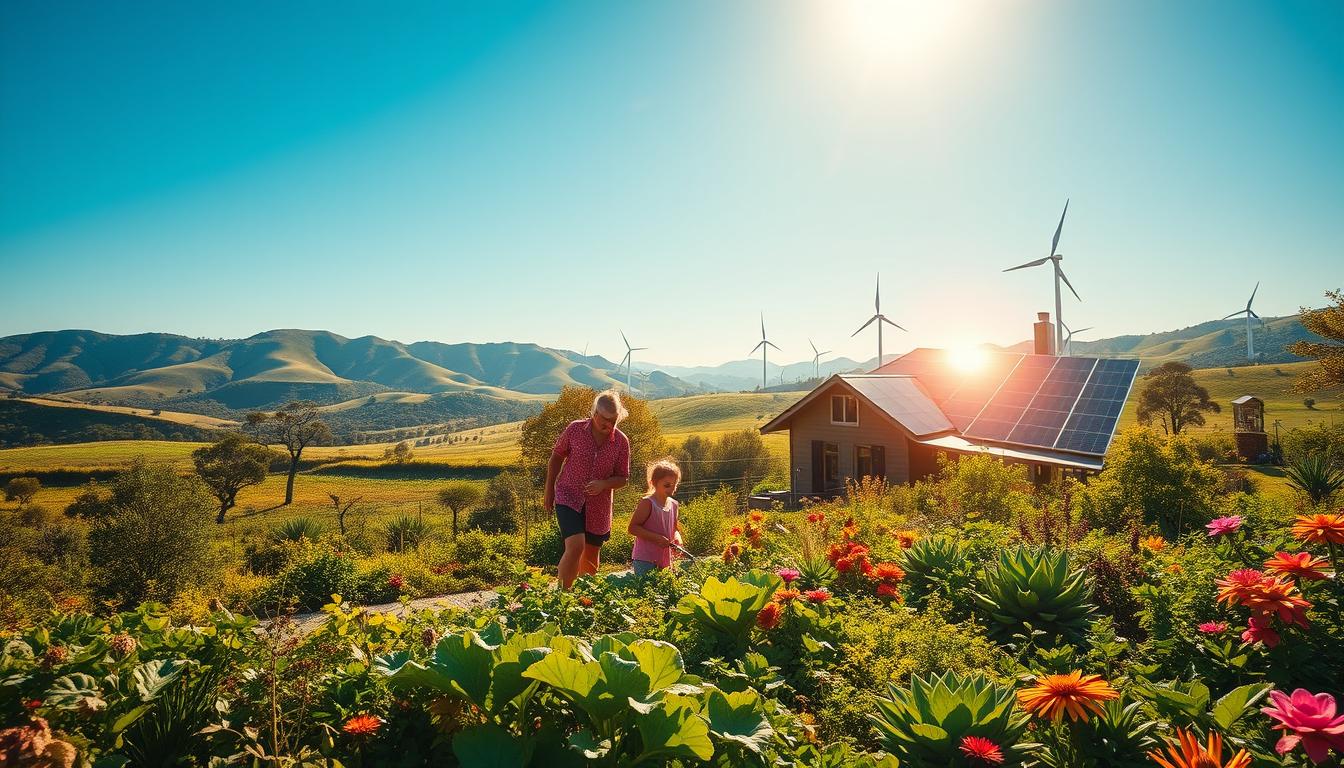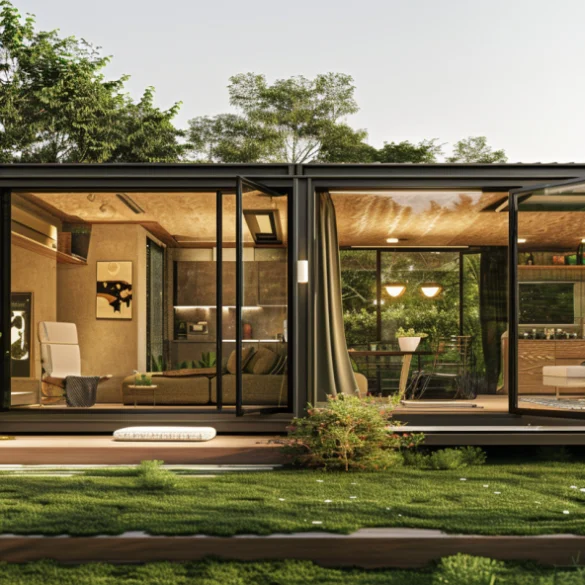This guide explores why the Powerwall, particularly the latest Powerwall 3, is a leading contender for energy storage in the Sunshine State, delves into its benefits, breaks down of Tesla Powerwall supply & install costs in QLD, and helps identify certified installers across Queensland. For Queenslanders blessed with abundant sunshine, harnessing solar power is a smart move towards a more sustainable and cost-effective lifestyle. But to truly unlock energy independence and make the most of those golden rays, a home battery like the Tesla Powerwall is becoming an increasingly popular choice.
Table of Contents
Is a Tesla Powerwall Right for Your Queensland Home in 2025?
The fundamental appeal of a system like the Tesla Powerwall lies in its ability to store excess solar energy generated during the day for use at night or during power outages. This capability is particularly pertinent in Queensland, where the ample sunshine provides a rich source for solar generation. By capturing and storing this energy, homeowners can significantly reduce their reliance on the electricity grid, enhance their energy security, and contribute to a more sustainable energy future.
Understanding the Buzz: What Makes Powerwall a Leading Choice?
Tesla Powerwall has established itself as a premier home battery system, recognized for its sleek design, advanced technology, and robust performance in storing and deploying solar energy. A key attraction is its substantial energy capacity, with each unit offering 13.5 kWh, sufficient for many homes’ overnight needs. Beyond capacity, the Powerwall provides critical backup power during grid outages, a valuable feature for uninterrupted living.
Management of the system is streamlined through the intuitive Tesla app, which allows homeowners to monitor energy flow, customize settings, and control their energy usage effectively. The Powerwall is also noted for its reliability and seamless integration with solar systems, enhancing its appeal.
A significant, often understated, draw for consumers is the cohesive experience offered by the broader Tesla ecosystem. For those already invested in or considering other Tesla products, such as solar panels or electric vehicles (EVs), the Powerwall integrates smoothly. The Tesla app can manage solar panels and even the Model S or X alongside the Powerwall. Furthermore, the Powerwall 3, in conjunction with a Tesla Wall Connector and a compatible vehicle, can facilitate a form of Vehicle-to-Home (V2H) power transfer without requiring additional specialized V2H hardware. This interconnectedness suggests that the decision to invest in a Powerwall can be influenced by a desire for this ecosystem synergy, where the battery is not just a standalone device but a component of a larger, harmonized energy solution, simplifying management and potentially boosting overall system efficiency and user satisfaction.
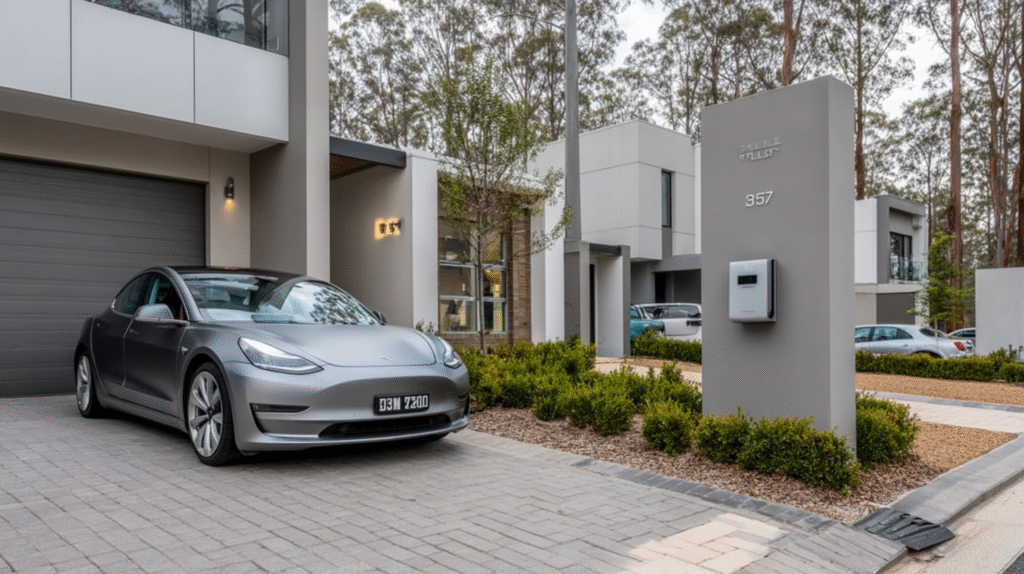
Powerwall 3 vs. Powerwall 2: Key Differences for QLD Homeowners
Tesla offers different versions of the Powerwall, and understanding their distinctions is crucial. The Powerwall 3 is the latest iteration, primarily designed for new solar and storage system installations. A significant advantage of the Powerwall 3 is its integrated solar inverter, which can provide up to 11.04 kW AC of continuous power and support up to 20 kW of solar panels. This integrated design can simplify installation and potentially reduce overall system costs for new setups. The Powerwall 3 also boasts a higher continuous power output of 10 kW compared to the Powerwall 2’s 5 kW, allowing it to support more high-demand appliances simultaneously. Another notable feature is its enhanced flood resistance, capable of withstanding water up to 0.6 metres.
The Powerwall 2, however, remains a relevant and valuable option, particularly for homeowners looking to retrofit a battery to an existing solar system. Both the Powerwall 2 and Powerwall 3 offer the same usable energy capacity of 13.5 kWh per unit. There are differences in their physical dimensions and weight, with the Powerwall 3 being slightly heavier. In terms of scalability, the Powerwall 3 system can be expanded with up to four units, while the Powerwall 2 can scale up to ten units. The Powerwall 3’s design, which includes the inverter, means it doesn’t require an external gateway in the same way a Powerwall 2 might when retrofitted, streamlining the installation for new systems.
This strategic positioning—Powerwall 3 for new installations and Powerwall 2 for retrofits—reflects a careful approach to market segmentation by Tesla. This distinction could influence installer training, inventory management, and potentially the ease of finding installers specializing in one type of installation over the other. For instance, homeowners with existing solar inverters, especially those over 5 kW, might find the Powerwall 2 a more straightforward and potentially cost-effective retrofit solution. The future availability of “DC-coupled battery expansion units” for the Powerwall 3, potentially simpler units without the integrated inverter, could also make system expansions for Powerwall 3 owners more economical over time.
To clarify the main differences:
Tesla Powerwall supply & install costs in QLD
Quick Glance: Powerwall 3 vs. Powerwall 2
| Feature | Powerwall 3 | Powerwall 2 |
| Target Installation | New solar & storage systems | Retrofit to existing solar systems |
| Integrated Inverter | Yes (up to 11.04 kW AC, supports 20 kW solar) | No (requires separate solar inverter) |
| Continuous Power Output | 10 kW (locally capped from 11.04 kW) | 5 kW |
| Scalability | Up to 4 units | Up to 10 units |
| Key Design/Durability | Flood resistant up to 0.6m | Standard weather resistance |
| Gateway Requirement | Integrated (part of the system) | Backup Gateway 2 required |
Sunshine State Benefits: Maximising Solar with Battery Storage with Tesla Powerwall supply & install costs in QLD
Queensland’s high solar irradiation levels make it an ideal location for generating substantial surplus solar energy. A Tesla Powerwall allows homeowners to capture and store this excess energy, which would otherwise be fed back into the grid, often for a modest feed-in tariff. This stored energy can then be used during the evening peak hours when electricity tariffs are typically higher, or during cloudy periods and at night, thereby significantly reducing reliance on purchasing electricity from the grid.
Energy security is another compelling benefit, particularly relevant during Queensland’s storm season or in areas prone to grid outages. The Powerwall provides reliable backup power, ensuring essential appliances continue to operate seamlessly. This capability can offer considerable peace of mind.
Financially, the primary benefit comes from reduced electricity bills achieved by maximizing the self-consumption of solar energy. Given that the average Queensland household uses around 6,169 kWh of electricity annually, with yearly costs potentially ranging between $1,500 and $1,800 , the savings from self-generated and stored solar power can be substantial. Average electricity usage rates in Queensland hover around 25-33 cents per kWh.
The economic case for battery storage is further strengthened by the trend of decreasing solar feed-in tariffs (FiTs) in Queensland. For instance, the solar feed-in tariff for regional Queensland in 2025-26 is set at 8.66 cents per kWh, a significant 30% decrease from the previous year’s 12.38 cents per kWh. A draft determination indicated a similar figure of 8.69 c/kWh. This growing disparity between the cost of purchasing grid electricity and the remuneration for exporting solar makes storing and using one’s own solar energy far more financially advantageous. A Powerwall facilitates this shift, making the investment increasingly logical as the value of exporting diminishes and the savings from avoiding grid purchases rise.
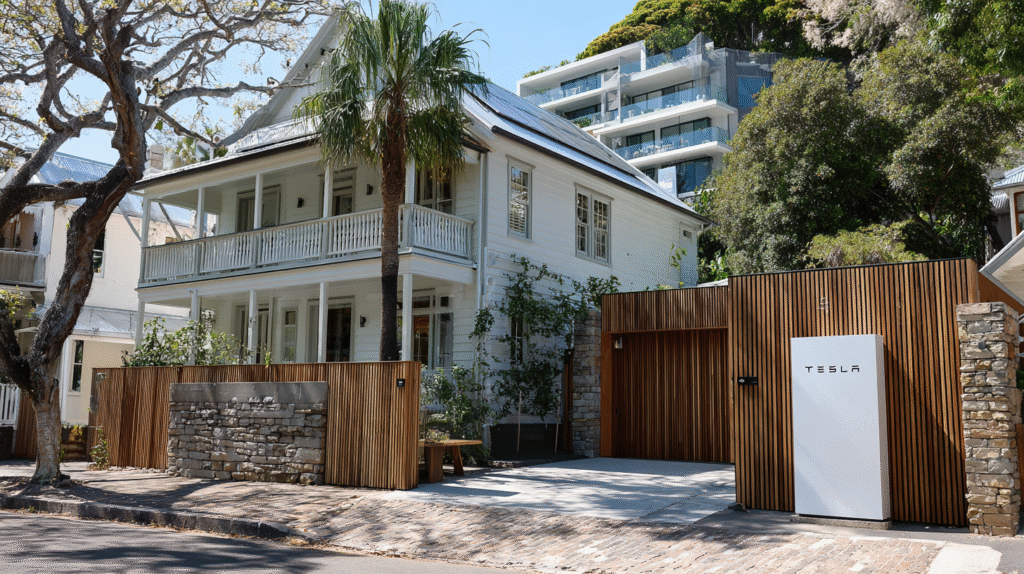
Decoding the Dollars: Tesla Powerwall supply & install costs in QLD
Understanding the financial investment required for a Tesla Powerwall 3 is a critical step for any homeowner. The total cost encompasses the hardware itself—the Powerwall unit and the necessary Gateway—as well as installation fees and other potential charges.
Hardware Breakdown: Powerwall Unit and Gateway Costs
The Tesla Powerwall 3 unit itself is priced at $11,900, inclusive of GST. To enable backup functionality and manage the system’s interaction with the grid, a Tesla Backup Gateway 2 is also required. Tesla’s direct pricing for the Gateway 2 is $1,950 , although some industry sources have cited $1,700. Using the direct figures, the total hardware cost for a single Powerwall 3 and Gateway 2 is approximately $13,850. It’s important to note that this price does not include delivery, installation, or other associated costs and fees.
The inclusion of an integrated hybrid solar inverter within the Powerwall 3 unit is a significant factor in its hardware price. A comparable standalone hybrid inverter could cost between $2,000 and $4,000 or more. For homeowners installing a new solar system, who would need to purchase an inverter regardless, the Powerwall 3’s bundled approach offers inherent value. When evaluating its cost for a new system, one might consider the price of the Powerwall 3 package relative to purchasing a battery and a separate, comparable inverter. This perspective often makes the Powerwall 3’s value proposition more apparent for new installations, aligning with Tesla’s market positioning for this product.
Installation Expenses: What to Expect from Certified Installers
Installation costs for a Tesla Powerwall are separate from the hardware purchase and can vary based on several factors. Typically, installation expenses range from $1,000 to $2,500 or more. The final, all-inclusive price will always be provided by a Tesla Certified Installer after a site assessment.
Considering these installation estimates, the total installed cost for a single Powerwall 3 system in Queensland is likely to be in the range of approximately $14,850 to $16,350 or higher. Some industry analyses suggest a total installed cost of around $14,600 to $16,000.
The geographical diversity of Queensland can also play a role in installation pricing. Installers operating in more remote regional areas may incur higher overheads related to travel and logistics compared to those in metropolitan Brisbane. While specific regional price variations for Powerwall installations are not explicitly detailed in available information, it is a general principle in service industries that location can influence cost. Homeowners in regional or country Queensland might therefore anticipate costs potentially falling at the higher end of the installation spectrum or may need to clarify if travel surcharges apply, especially if the chosen installer is not based locally.
Factors That Can Influence Your Final Quote
Several variables can influence the final quotation provided by a certified installer:
- System Complexity: The condition of the existing switchboard, any necessary wiring upgrades, and the chosen location for the Powerwall unit(s) (e.g., indoor or outdoor, wall-mounted or floor-mounted) can all affect installation complexity and cost.
- Number of Powerwalls: The Powerwall 3 system is scalable, allowing for up to four units to be installed together for increased capacity. Each additional unit will add to both hardware and installation costs.
- Location: As previously mentioned, installations in regional or remote areas may incur higher costs due to travel and logistical considerations.
- Existing Solar System (for Powerwall 2 retrofits): If considering a Powerwall 2 for an existing solar setup, factors such as the age of the solar panels, their string configuration, and the compatibility of the current solar inverter will be assessed and could influence the installation scope and price. The Powerwall 3 is generally intended for new solar installations.
- Installer Overheads and Margins: Different installation businesses will have their own pricing structures reflecting their operational costs and profit margins.
- Delivery Fees: Tesla’s direct hardware pricing explicitly excludes delivery fees, which will be an additional cost factored into the installer’s final quote.
Tesla Powerwall 3 Estimated Total Cost in Queensland (Single Unit)
| Cost Component | Estimated Price Range (AUD) |
| Powerwall 3 Unit (incl. GST) | $11,900 |
| Tesla Backup Gateway 2 (incl. GST) | $1,950 |
| Estimated Installation & Other Fees | $1,000 – $2,500+ |
| Estimated Total (Before Rebates & Incentives) | $14,850 – $16,350+ |
Note: Prices are estimates and can vary. Always obtain a detailed quote from a Tesla Certified Installer.
Power Up Your Savings: Government Rebates and Incentives for Queenslanders
Government incentives can play a significant role in making home battery systems more affordable. For Queenslanders, the primary upcoming incentive is a federal program, as the landscape for state-specific rebates has changed.
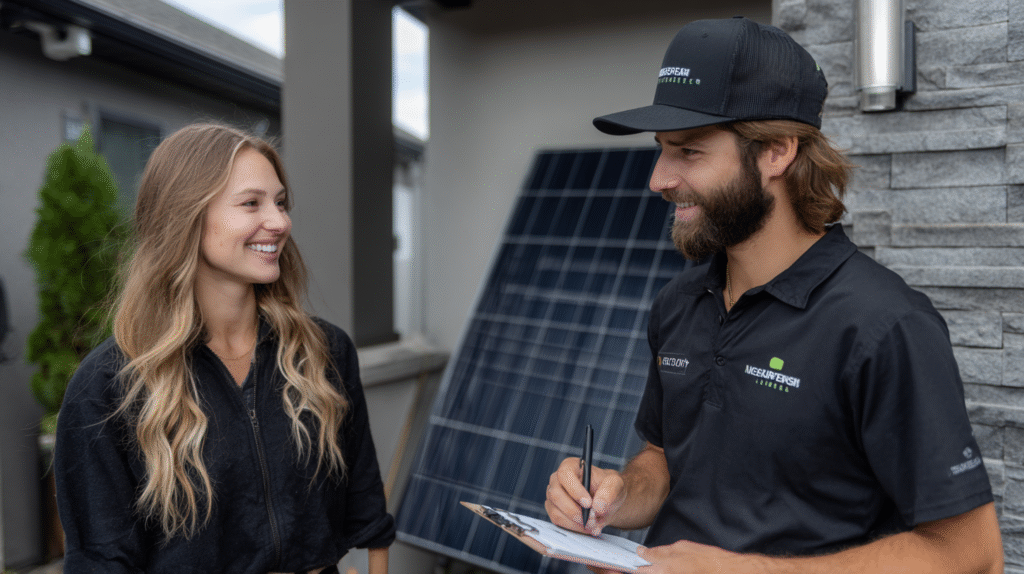
The Federal Cheaper Home Batteries Program (From July 1, 2025)
The Australian Federal Government is set to launch the “Cheaper Home Batteries Program” on July 1, 2025. This program aims to provide an upfront discount of approximately 30% on the cost of installing eligible small-scale battery systems.
More specifically, the rebate is expected to be up to $372 per kWh of usable battery capacity, applicable for batteries ranging from 5 kWh to 100 kWh, with the rebate eligibility capped at the first 50 kWh of capacity. For a “typical” 11.5 kWh battery system, this could equate to a discount of around $4,278. The program will be delivered through the Small-scale Renewable Energy Scheme (SRES), with the discount generally applied by solar and battery retailers or installers at the point of sale.
Eligibility criteria will apply and may relate to factors such as the size of the battery system, whether the applicant is a household or a small business, household income levels, property type, and the timing of the installation.
While the federal program was designed with the intention of being “stackable” with state-based incentives , the practical benefit of this feature for Queenslanders is currently limited. Reports indicate that Queensland’s previous state-level battery rebate, which offered up to $4,000, closed in December. This means that, unlike residents in some other states who might be able to combine federal and state aid, Queenslanders will likely primarily benefit from the federal rebate for new battery installations after its commencement in July 2025. This situation underscores the dynamic nature of government incentives and the importance for homeowners to stay informed about programs at both federal and state levels.
Are There Still QLD State or Local Incentives?
As mentioned, Queensland’s significant state-level battery rebate program appears to have concluded. While some general information points to the possibility of state, territory, or local council schemes , specific, active battery rebates for Queensland are not prominent in recent information.
Homeowners should always consult official Queensland Government energy websites, such as those managed by the Queensland Rural and Industry Development Authority (QRIDA) or the Department of Energy and Climate, for the most current information on any new or revived state or local council programs, as these can be subject to change.
It is also worth noting the Small-scale Technology Certificates (STCs) program. This is a federal incentive that reduces the upfront cost of installing new solar PV systems themselves. While not a direct battery rebate, it is relevant for homeowners planning a new solar-plus-storage installation, as it lowers the overall investment in the solar generation component.
The closure of state-specific rebates in Queensland and other states like New South Wales and Victoria before the federal scheme begins could create a temporary “incentive vacuum.” This might lead some consumers to delay their battery purchase until July 2025 to access the federal rebate. Alternatively, installers could face increased pressure to offer more competitive pricing or package deals to maintain sales momentum during this interim period.
Finding Your Spark: Certified Tesla Powerwall Installers in Greater Brisbane
Selecting a qualified and experienced installer is as crucial as choosing the right battery system. For Tesla Powerwall installations, it is essential to engage a Tesla Certified Installer to ensure warranty validity and optimal system performance.
Questions to Ask Potential Installers
When evaluating potential installers, homeowners should consider asking the following questions:
- Are you a Tesla Certified Installer? This is paramount for warranty and expertise.
- Can you provide a detailed, itemised quote that breaks down hardware costs, installation fees, and any additional charges such as travel for regional installations?
- What is your specific experience with Tesla Powerwall installations, distinguishing between Powerwall 3 (for new systems) and Powerwall 2 (for retrofits)?
- What warranties do you offer on your workmanship, separate from Tesla’s product warranty?
- Can you clearly explain the process and timelines for obtaining grid connection approval from the local Distributor Network Service Provider (DNSP) like Energex?
- What after-sales support, system monitoring guidance, and troubleshooting assistance do you provide post-installation?
- (For regional customers) Does your quotation comprehensively include all potential travel and accommodation costs, if applicable?
An installer’s familiarity with local network regulations, such as those set by Energex in Southeast Queensland, and their proficiency in navigating the grid connection approval process are critical yet often overlooked aspects. The Powerwall 3, for example, has a technical capability of 11.04 kW continuous power, but local DNSP regulations might require it to be capped at 10 kW to prevent grid disruption. Installers like Halcol Energy highlight their “deep understanding of Brisbane’s energy market and regulations” , while regional installers like Scott Burke Solar state they manage “Ergon Energy Applications”. A failure by the installer to correctly manage these regulatory aspects could lead to installation delays, non-compliant systems, or an inability to connect to the grid or participate in Virtual Power Plant (VPP) programs.
Spotlight: Reputable Installers in the Brisbane Area
Several Tesla Certified Installers operate in the Greater Brisbane region. Homeowners should always verify current certification and obtain multiple quotes. Some installers mentioned include:
- Solarwise: Certified Tesla Powerwall installers based in Brisbane, with experience in retrofitting existing solar systems (likely with Powerwall 2). Their office is at 43 Chetwynd Street, and they can be reached at 1800 805 287.
- Halcol Energy: Provides Tesla Powerwall installations across Brisbane, including the CBD, northern, southern, eastern, and western suburbs, and the wider Greater Brisbane region. They also service areas like the Sunshine Coast and Logan City, and mention expertise with the “latest Tesla energy storage technology,” suggesting a focus on Powerwall 3 for new systems. They can be contacted at (07) 5438 8133 or (07) 3106 9960.
The differing emphasis—Solarwise on retrofitting and Halcol Energy on the latest technology—suggests that homeowners should align their specific needs (new installation versus retrofitting an existing solar system) with an installer’s apparent specialisation or primary product focus. While many certified installers can handle both scenarios, some may have more recent or extensive experience with either Powerwall 2 retrofits or Powerwall 3 new integrations.
It is always advisable to consult Tesla’s official website for the most current and comprehensive list of certified installers in a specific postcode.

Beyond the City: Certified Installers in Regional & Country Queensland
Access to certified installers is vital across all of Queensland. Fortunately, a number of Tesla Certified Installers serve regional and country areas.
Gold Coast & Sunshine Coast Options
- Gold Coast Energy: An authorized Tesla Energy Reseller and Certified Installer serving Southeast Queensland and Northern New South Wales. They report having completed over 20 Powerwall installations. Located at 5 Appaloosa Court, they can be contacted at 07 5525 2111.
- Halcol Energy: As noted for Brisbane, their service area extends to the Sunshine Coast.
- Solar Link Australia: A Tesla Certified Installer that can service new and existing customers, potentially offering broader Queensland coverage. Their contact is 1800 155 597.
Toowoomba, Ipswich & Darling Downs
- GES Energy: A Tesla accredited designer and installer operating in Toowoomba. They can be reached at 1300 811 031.
- Halcol Energy: Services Toowoomba and Goondiwindi, indicating coverage in the Darling Downs region.
Central Queensland (Rockhampton, Gladstone, Mackay)
- Reef Solar & Electrical: A premium authorized Tesla partner for Gladstone and Rockhampton, also serving Yeppoon and Agnes Water.
- Solahart Rockhampton: A Certified Installer of the Tesla Powerwall 2.
- Solahart Mackay: Offers the Tesla Powerwall 3.
- Solahart Townsville: While based further north, their information may be relevant for broader regional inquiries and they offer Powerwall 3.
- GES Energy: A Tesla accredited designer and installer with services in Mackay and Townsville.
North Queensland (Townsville, Cairns)
- Solahart Townsville: Provides the Tesla Powerwall 3 and is a Certified Installer.
- GES Energy: Offers Tesla Powerwall installations in Townsville as an accredited designer and installer.
- Replenishable Energy: The exclusive Cairns Tesla Powerwall Certified Installer, mentioning experience with Powerwall 2. Contact them at (07) 4031 2251 or 1300 682 773.
- Solahart Cairns: A Certified Installer of the Tesla Powerwall 2.
Wide Bay-Burnett (Bundaberg, Hervey Bay)
- Solahart Bundaberg: Offers the Tesla Powerwall 3 and is a Certified Installer. Located at 13 Princess Street, Bundaberg, phone 1300 362 821.
- Scott Burke Solar: A Tesla Powerwall Certified Installer based in Bundaberg (8 Campbell St, Bundaberg East) and also serving Hervey Bay. They mention experience with Powerwall 3 and importantly, state they handle “Ergon Energy Applications”.
The prevalence of Solahart branches as certified installers across multiple regional Queensland towns indicates a significant commitment by this national brand to Tesla products. This can offer a degree of standardized service and product accessibility for regional customers. However, it’s notable that some Solahart branches specifically mention Powerwall 2 , while others highlight Powerwall 3. This variation may be due to the timing of website updates, local stock availability, or specific expertise within that branch. Therefore, while Solahart is a familiar name, customers should verify with their local branch which Powerwall model they are currently focused on and certified to install.
Furthermore, the explicit mention by some regional installers, like Scott Burke Solar in Bundaberg , that they manage “Ergon Energy Applications” is a critical value-add. Ergon Energy is the DNSP for most of regional Queensland, and navigating their grid connection approval process can be complex. An installer who proactively manages this provides a significant service, reducing potential stress and delays for the homeowner. This is a key differentiator and an important question for homeowners in Ergon Energy’s territory to ask potential installers.
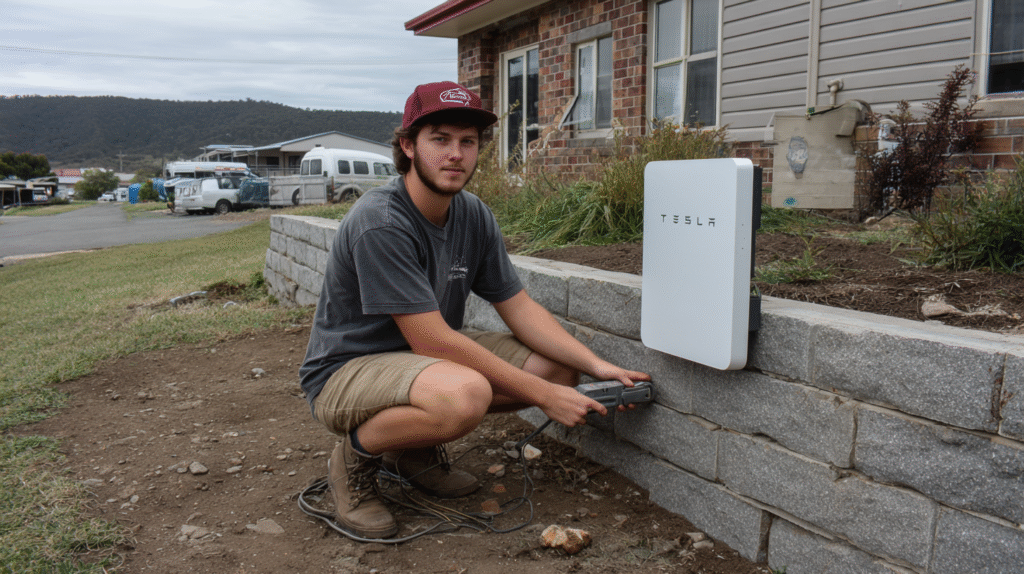
The Installation Journey: What to Expect
Embarking on a Tesla Powerwall installation involves several key stages, from initial consultation through to commissioning and ongoing energy management.
From Quote to Commissioning: A Step-by-Step Guide
The typical process for a Tesla Powerwall installation unfolds as follows:
- Initial Consultation & Site Assessment: An installer will typically visit the property to assess energy needs, evaluate the existing solar system (if any), inspect the switchboard, and determine the most suitable location for the Powerwall unit(s) and Gateway. Companies like Halcol Energy detail this initial analysis of needs and site specifics.
- Quote Provision: Following the assessment, homeowners will receive detailed, itemised quotes from one or more certified installers.
- System Design: The installer will design a Powerwall system tailored to the home’s specific requirements and the findings from the site assessment. Installers like Scott Burke Solar include system design as part of their service.
- Approvals: A crucial step is obtaining grid connection approval from the local DNSP (Energex for Southeast Queensland, Ergon Energy for regional Queensland). The installer typically manages this application process.
- Installation Day: The physical installation of the Powerwall unit(s) and the Backup Gateway 2 will take place. This usually takes a full day but can vary depending on complexity. The work involves safe and compliant electrical procedures.
- Commissioning & System Handover: Once installed, the installer will activate the system, connect it to the home’s Wi-Fi network for monitoring capabilities, and provide a comprehensive explanation of its operation, including how to use the Tesla app. Thorough system testing is usually conducted before handover.
Living with Powerwall: Using the Tesla App and Monitoring Energy
A significant aspect of the Powerwall experience is the ability to monitor and manage energy use via the Tesla mobile app. This app provides real-time insights into:
- Solar energy production
- Battery charge and discharge status
- Home energy consumption
- Electricity imported from or exported to the grid
Homeowners can customize Powerwall’s operational modes through the app, such as “Self-Powered” mode (to maximize self-consumption of solar energy) or “Backup-Only” mode (to reserve battery capacity for outages). The system is designed to learn and adapt to energy usage patterns over time and receives over-the-air software updates that can introduce new features and enhance existing ones, ensuring the Powerwall continues to evolve and improve.
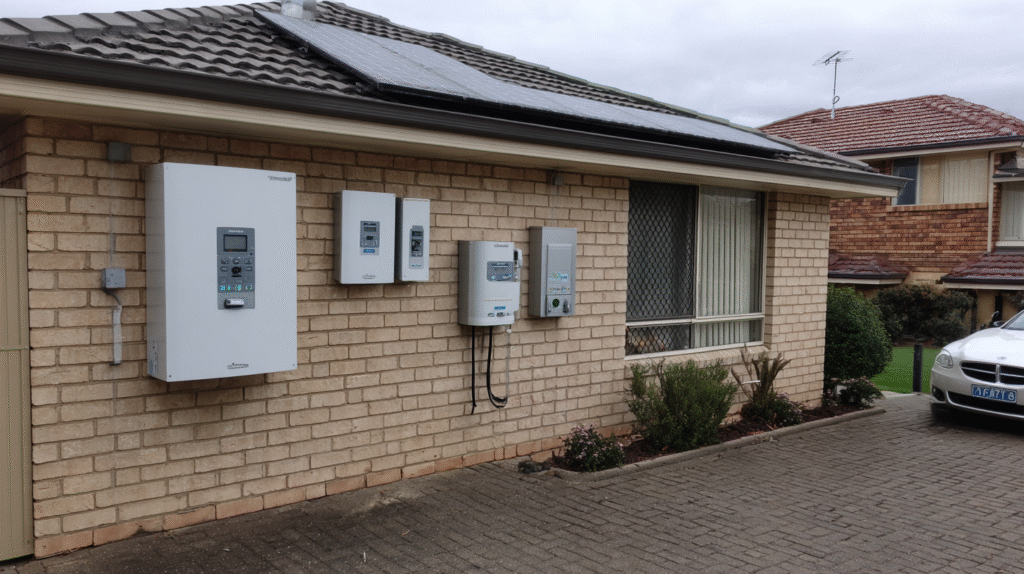
Beyond Tesla: A Quick Look at Other Home Battery Options
While the Tesla Powerwall is a prominent and highly regarded home battery solution, the market offers a range of other reputable brands. Being aware of these alternatives can be beneficial for homeowners conducting thorough research.
Considering Alternatives: When to Look Further?
Other popular home battery brands available in Australia include:
- Sungrow: Often ranked highly by installers and consumers for providing good value and performance. Their modular SBR HV battery is a notable product.
- Alpha ESS: Another brand gaining traction in the Australian market.
- BYD: Known for its partnership with inverter manufacturers like Fronius, offering compatible battery solutions.
- Sonnen: A German-engineered brand recognized for its smart technology, focus on LFP (Lithium Iron Phosphate) battery chemistry, and long warranties.
- LG Energy Solution (formerly LG Chem): Their RESU series is known for being compact and efficient, offering flexibility in capacity.
- Sigenergy: A relatively new entrant that has quickly gained market share and positive installer feedback for its SigenStor, an “all-in-one” system integrating battery, inverter, EV charger, and energy management.
Sustainable Home Magazine
Homeowners might consider alternatives if they have specific technical requirements not met by Powerwall, different capacity needs that Powerwall's modularity doesn't optimally address, if their preferred local installer specializes in another brand, or if they find a different price point or unique feature (like Sigenergy's integrated bi-directional EV charger ) more appealing.
The Australian home battery market is dynamic and competitive. The rapid rise of new players like Sigenergy, which reportedly captured significant market share and installer confidence shortly after its debut , illustrates this. This competition fosters innovation, such as integrated systems, diverse battery chemistries (like LFP favored by Sonnen ), and advanced capabilities like V2H charging. For consumers, this translates to a wider array of choices to find a battery that precisely fits their needs and budget, and potentially more competitive pricing over time as brands vie for market share. It also highlights the importance of staying informed about evolving market trends, as the “best” options can change.
Regardless of the brand, comprehensive research should always include comparing features, warranty terms, and the expertise and reputation of local installers for any chosen system.
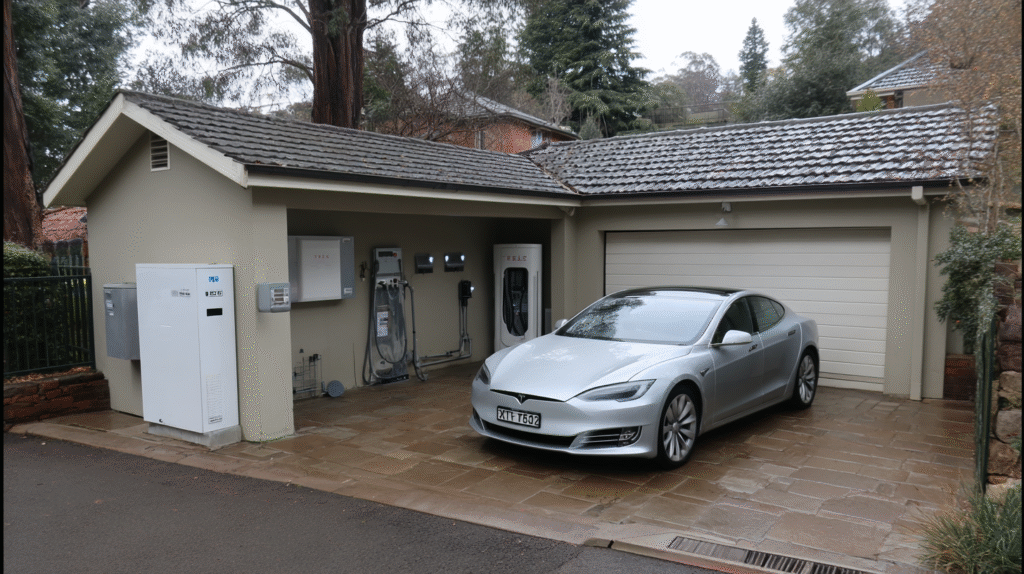
Making the Switch: Is a Tesla Powerwall a Smart Investment for Your QLD Home?
Ultimately, the decision to invest in a Tesla Powerwall, or any home battery system, involves carefully weighing the costs against the potential long-term benefits, including financial savings, enhanced energy independence, and alignment with sustainable living goals.
Calculating Your ROI: Long-Term Savings and Energy Independence
Several factors influence the return on investment (ROI) for a Tesla Powerwall:
- Current Electricity Consumption Patterns: Homes with higher electricity usage, particularly during peak tariff periods, stand to save more.
- Applicable Electricity Tariffs: The difference between peak and off-peak rates, and the general usage rate, will affect savings. Queensland electricity prices average around 29.72c/kWh, with variations between providers.
- Size of Solar PV System: The capacity of the solar panels to generate surplus energy for storage is crucial.
- Powerwall System Cost (after rebates): The net cost after applying any government incentives, such as the upcoming federal Cheaper Home Batteries Program , will determine the initial outlay.
- Future Electricity Price Trends: Anticipated increases in grid electricity prices can accelerate ROI.
- Solar Feed-in Tariffs (FiTs): As discussed, declining FiTs in Queensland (around 8.66 – 8.69 c/kWh for regional areas in 2025-26 ) make self-consuming stored solar energy more valuable than exporting it.
Maximizing the self-consumption of solar energy is the primary driver of financial savings. The energy independence and peace of mind provided by backup power during outages also hold significant, albeit non-monetary, value for many homeowners. The Tesla Powerwall comes with a 10-year warranty, providing a degree of assurance regarding its long-term performance. While online solar and battery ROI calculators can provide estimates, their outputs should be treated with caution as they depend heavily on the accuracy of the input data, which can vary greatly between households.
Final Checklist Before You Commit
Before making a final decision on a Tesla Powerwall installation, consider the following:
- Energy Needs Assessment: Have you thoroughly assessed your household’s actual energy consumption patterns and future needs?
- Multiple Quotes: Have you obtained and compared detailed quotes from at least two or three Tesla Certified Installers?
- Full Cost Understanding: Are you clear on all costs involved, including hardware, installation, any potential additional electrical work, and delivery fees?
- Warranty Terms: Have you understood the warranty conditions for both the Powerwall product (from Tesla) and the installation workmanship (from the installer)?
- Rebate Eligibility: Are you aware of the upcoming federal Cheaper Home Batteries Program, its eligibility criteria, and how it might impact your overall cost?
- Installer Reputation: Does your chosen installer have positive reviews, a solid track record, and demonstrable experience with Powerwall installations in your local area?
- Correct Powerwall Version: Have you determined whether the Powerwall 3 (for new solar installations) or the Powerwall 2 (for retrofitting to an existing solar system) is the appropriate choice for your situation?
Final Thoughts
Investing in a Tesla Powerwall in Queensland presents a compelling opportunity for homeowners to enhance their energy independence, reduce electricity bills, and contribute to a more sustainable energy future. The Powerwall 3, with its integrated inverter and robust features, is particularly well-suited for new solar installations, while the Powerwall 2 remains a viable option for retrofitting existing systems.
The cost of a Powerwall 3 system, including the unit, gateway, and typical installation, is estimated to be in the range of $14,850 to $16,350+ before any rebates. The upcoming federal “Cheaper Home Batteries Program,” commencing July 1, 2025, is poised to offer a significant discount of around 30%, potentially making the investment more accessible. However, Queensland’s state-specific battery rebates appear to have concluded, placing greater emphasis on the federal scheme.
A wide network of Tesla Certified Installers operates across Queensland, from Greater Brisbane to regional centers like the Gold Coast, Sunshine Coast, Toowoomba, Central Queensland, North Queensland, and the Wide Bay-Burnett region. Homeowners should diligently vet installers, focusing on their certification, experience, itemised quoting, and understanding of local grid connection requirements (Energex or Ergon Energy).
The decision to install a Powerwall should be based on a thorough assessment of individual energy needs, careful consideration of costs and benefits (including the impact of declining solar feed-in tariffs), and engagement with reputable certified installers. By taking these steps, Queenslanders can make an informed choice about harnessing the power of the sun, day and night.

